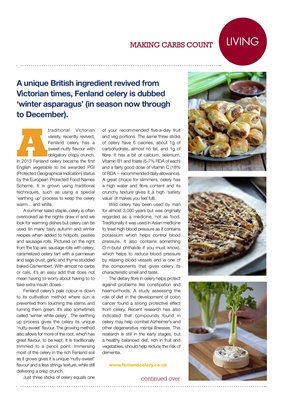
LIVING
continued over
A unique British ingredient revived from
Victorian times, Fenland celery is dubbed
'winter asparagus' (in season now through
to December).
Atraditional Victorian
variety, recently revived,
Fenland celery has a
sweet-nutty flavour with
obligatory crispy crunch.
In 2013 Fenland celery became the first
English vegetable to be awarded PGI
(Protected Geographical Indication) status
by the European Protected Food Names
Scheme. It is grown using traditional
techniques, such as using a special
'earthing up' process to keep the celery
warm… and white.
A summer salad staple, celery is often
overlooked as the nights draw in and we
look for warming dishes but celery can be
used tin many tasty autumn and winter
recipes when added to hotpots, pasties
and sausage rolls. Pictured on the right
from the top are: sausage rolls with celery;
caramelized celery tart with a parmesan
and sage crust; garlic and thyme studded
baked Camembert. With almost no carbs
or cals, it's an easy add that does not
mean having to worry about having to to
take extra insulin doses.
Fenland celery's pale colour is down
to its cultivation method where sun is
prevented from touching the stems and
turning them green. It's also sometimes
called 'winter white celery'. The earthing
up process gives the celery its unique
'nutty-sweet' flavour. The growing method
also allows for more of the root, which has
great flavour, to be kept. It is traditionally
trimmed to a pencil point. Immersing
most of the celery in the rich Fenland soil
as it grows gives it a unique 'nutty-sweet'
flavour and a less stringy texture, while still
delivering a crisp crunch.
Just three sticks of celery equals one
MAKING CARBS COUNT
of your recommended five-a-day fruit
and veg portions. The same three sticks
of celery have 6 calories, about 1g of
carbohydrate, almost no fat, and 1g of
fibre. It has a bit of calcium, selenium,
Vitamin B1 and folate (5-7% RDA of each)
and a fairly good dose of vitamin C (18%
of RDA -- recommended daily allowance).
A great choice for slimmers, celery has
a high water and fibre content and its
crunchy texture gives it a high 'satiety
value' (it makes you feel full).
Wild celery has been used by man
for almost 3,000 years but was originally
regarded as a medicine, not as food.
Traditionally it was used in Asian medicine
to treat high blood pressure as it contains
potassium which helps control blood
pressure. It also contains something
(3-n-butyl phthalide if you must know),
which helps to reduce blood pressure
by relaxing blood vessels and is one of
the components that gives celery its
characteristic smell and taste.
The dietary fibre in celery helps protect
against problems like constipation and
haemorrhoids. A study assessing the
role of diet in the development of colon
cancer found a strong protective effect
from celery. Recent research has also
indicated that compounds found in
celery may help combat Alzheimer's and
other degenerative mental illnesses. This
research is still in the early stages, but
a healthy balanced diet, rich in fruit and
vegetables, should help reduce the risk of
dementia.
www.fenlandcelery.co.uk